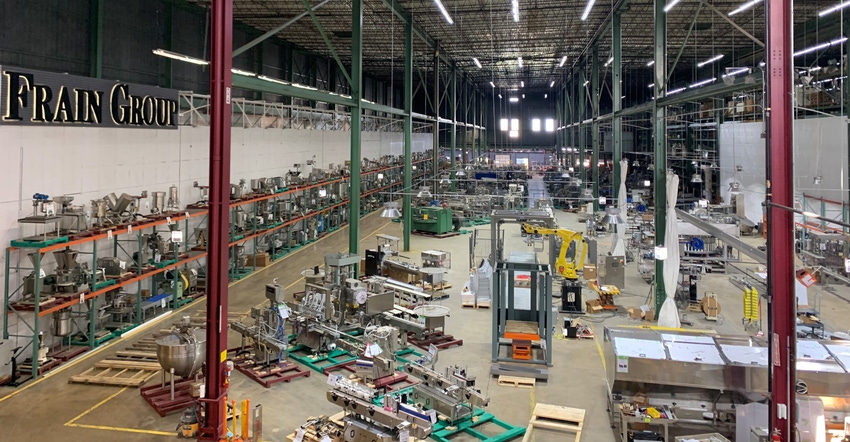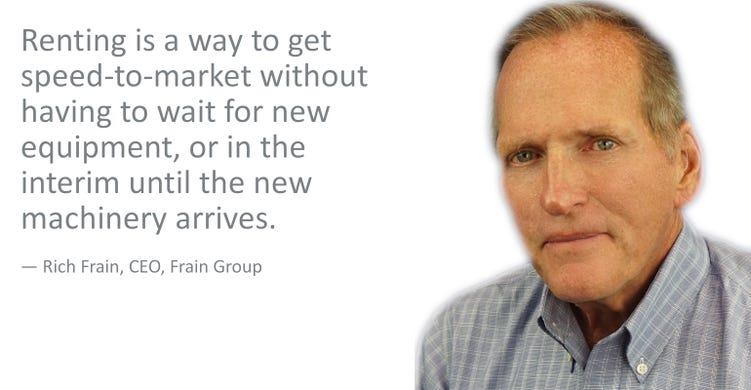Equipment Rentals are Red Hot — Here’s Why
Packaging equipment business expert reveals why rentals have steadily risen against a backdrop of new product launch pressures and COVID-19.
September 22, 2020

What’s the hottest trend in buying packaging equipment in a post-pandemic recession for consumer packaged goods (CPG) companies? How has COVID-19 affected whether you buy packaging equipment new or used? Or whether you buy, lease, or rent?
We asked Rich Frain, CEO of Frain Group, a single-source provider of integrated processing and packaging machinery solutions whose inventory includes roughly 9,000 pieces at its two million square-foot facility outside Chicago in Carol Stream, IL.
The company provides all manner of new and used equipment through sales, leases, and rentals, so we were happy the CEO took time out to discuss buying trends.
What big trend do you see driving the way companies are buying packaging equipment?
Frain: There’s a huge push by CPGs to get new products to market. I believe I read the number to be 60,000 new SKUs [stock-keeping units] a year. More than double the number of new products over the last 15 years. Products from leading brands are experiencing challenges from new product start-ups eating away at traditional leaders' margin and market share — they just don’t have the growth and profits they used to have, and CPGs know this.
Also, ecommerce and trends like single-serve package goods are amplifying the changing patterns of consumers usage. All of these items combined are forcing companies to look at things in different ways. They’re hellbent on coming out with those 60,000 new SKUs to maintain dominance, and everybody ignores the 76% as failure rate in 12 months per research from Nielsen. All these things are forcing manufacturers to think about everything in different ways, and that’s a big deal, considering they’re trying to do this when they have scarce resources to produce those products.
What are the trends you see in terms of buying new vs. used, as well as how people buy?
Frain: In the last 12 years we have evolved our business model. We no longer sell used machinery the traditional way. Since 2008, companies started getting rid of the extra mechanic here, the extra engineer there. With employees working at 110%, it was very difficult to deal with getting a piece of used equipment set up and working right, even one starting in very good condition. Just as an example, we might put 160 hours into a machine, with those hours split between four or five associates — electricians, mechanics, engineers, clean-and-paint. Which is 50% less time than it would take for a company that doesn’t do this every day.
At the same time, it’s almost impossible to get new or even used equipment on a timely basis. As soon as Frain receives a piece of used equipment that’s in the top 10% or 20% of what people require, it’s gone. So we have augmented our sales with rentals. At the same time, demand for new equipment is so high, but the lead time for it is anywhere from three to six months.
Renting is a way to get speed-to-market without having to wait for new equipment, or in the interim until the new machinery arrives. Also consider that we could be talking about not just a single piece of equipment, but an entire new packaging line. The average queue to build a new line is usually 8 to 10 months and you’re usually working with multiple machinery manufacturers. You may think you can get equipment fast, but you can’t always get it all at the same time. If a $12,000 coding system doesn’t show up on time, you’re stuck — you can’t do anything with that line. It equals months of lost sales to get that product to market negatively impacting an organizations bottom line.

You cite 2008 vs. today — recession then and recession now. Do rentals spike or is this a steady trend?
Frain: This is not just a recession trend, it’s a market demand, and it just keeps growing for us. Let me put it this way: In 2008, rental was 20% of our business; in 2020, it’s 75% of our business. Look at the market and how things have changed over that timeframe, ecommerce has exploded, changing consumer base and their different demands. The reality is now, only 20% of buyers pay cash up front.
It’s not that companies don’t have money, but many of the largest brands haven’t brought in much shareholder value in 10 years. They used to spend $300 to $600 million a year, just buying everything they needed. But over the last decade, they’ve tightened up their belts. They would much rather invest that free cash in innovation and new product development. They are looking for different ways to handle infrastructure investment.
Each plant now must justify the internal money spending. That’s driven rentals up. Rentals are a variable expense, as opposed to when you lease or buy, because those are a fixed expense. You can’t get out of those fixed expenses, even if you stop using the equipment and there’s no money coming in.
How is a rental agreement structured?
Frain: We have a three-month minimum. Upon completion, the unit can be rented on a month-to-month basis or stop at any time. Compare that to buying or leasing, which locks you into payments for 12, 24 or 36 months.
In addition, a rental is a variable expense vs. a lease, which is a fixed expense. If you’re renting a piece of equipment for $2,500 per month, and it’s no longer required, you just return it. But if you’re paying $2,500 a month to a lease, and you no longer require the machine, you still owe payments through the end of your lease term, whatever that is.
When you rent equipment, you’re paying one-thirtieth to one-fortieth of the cash flow that would normally be spent on a piece of new equipment. So, if you’re buying a new machine for $100,000, you’re going to put 50% out today, and you’ll owe the rest in six months when it comes in. That’s not chump change, even for a large brand or manufacturer today, when you consider they may have multiple plants that want to spend $50,000 every day.
On average, our rental is between $2,500 and $3,500 a month. That’s much easier to get approval from your CFO or controller.
What if a buyer wants to do a rent-to-own down the road but doesn’t know up front?
Frain: Our rental clients receive follow up calls to allow the option to convert rentals, over a fixed expense. The conversion rate is about 50/50: Approximately 50% of the client base chooses to keep the equipment as a variable expense.
So is rental more a way to hedge financial risk, or a stop-gap while you’re waiting for equipment to be shipped?
Frain: It’s absolutelyboth. The ideal way to do this is to “rent until you know,” or “pay as you grow” rental as an insurance policy before buying. This allows you the first 90 to 120 days of production to see how well the product is doing in the marketplace. If you’re getting the reorders, the rental can be converted into a lease, or you can make the outright purchase. A portion of the rental payment will apply to both the purchase or the lease, and 22 months later you can own it.
These options give our customers flexibility, and what makes us a popular option with them. Most of the time, renting is used as an insurance policy against risk. And to a lesser degree, companies rent when they order a new machine but need to get their line up and running until it comes in. And it doesn’t matter how you get your equipment. We do it all three ways: buy, lease, or rent.
Frain rents, leases, and sells equipment, but says rentals are riding high as CPGs back away from investing millions of dollars in new capital equipment purchases.
Let’s address COVID-19 —how has it affected equipment purchasing?
Frain: At least 45% of our business is in the food industry, and a lot of that went belly up at first. Then we saw some changes; we sent eight or nine shrink bundlers out in the first few weeks, for overwrapping tray packs in order tomaintain sanitization of the offerings. That drove a lot of orders, because there was no way to get new equipment to build up production capacity fast enough.
And, of course, there’s hand sanitizer. We’re on our 12th hand sanitizer line for people packaging everything from 100 gallons a minute to 16-ounce packs at 40 a minute. Every client is renting. You might get a good year out of it, but would you really want to commit to owning that equipment for only a year due to the unknown of the pandemic? We’ve also had a huge run of tanks due to COVID-19. Our focus on the rental model has allowed organizations speed to market, and financial flexibility at this vital time.
Has the pandemic changed who’s involved in an equipment decision?
Frain: Rental is our single best product, and the CEO’s and CFO’s of the world understand this concept. They understand managing risk and thinking about optimal cash flow options for the organization. People below that level do not always have the perspective of the overall organizations’ health. Their perspective is a project-based decision, vs. strategic organizational decision. They don’t believe or consider the stats about the huge rejection rate for new products. They just know they need to get a line running.
When the pandemic hit, CEOs and CFOs were literally coming in with their checks with them. They want variable expense as insurance against that 76% failure rate hanging over their heads all the time. If you do a lease, the money coming in pays the lease, but if the product fails in 12 months, normally on a lease, you’re paying for 24 or 36 months, and you’re still have to make payments on something that’s making absolutely no money.
And then they have to sell that machine on the used market. Will you buy it back at a good price?
Frain: Of course we will talk to customers about buying equipment. We have our finger on the pulse of the market, and we know what products are in demand. Keep in mind that we have two million square feet, and somewhere around 9,000 machines on-hand.We’ve bought many brand-new pieces of equipment that have never been used, and we are finding more and more demand in the rental market to turn the right pieces around…
About the Author(s)
You May Also Like


